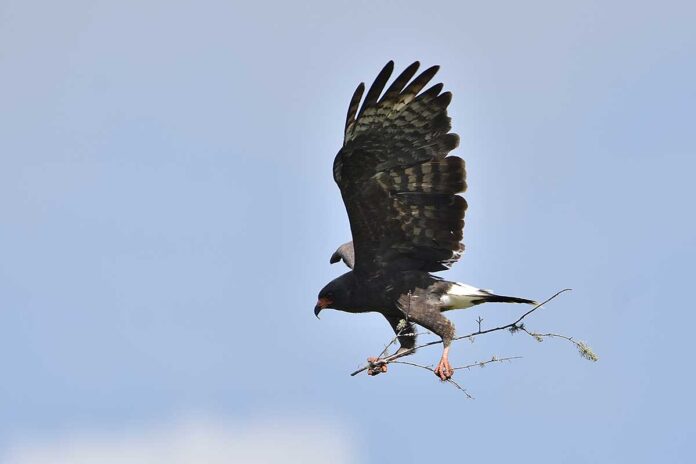The road to Flamingo in Everglades National Park is long and not particularly winding. Driving it some days, it feels like you could bungee cord the steering wheel, take a nap, and wake up refreshed, still in the same lane. This is not recommended. Also, you would miss all that openness, and all those calming acres of sawgrass, as well as the cypress domes, the mahogany hammocks, and the chance to see gators, bobcats, roseate spoonbills, eastern meadowlarks, swallow-tailed kites, great egrets and a lot of other wildlife.
On my first trip down there, about 25 years ago, I kept a sharp eye out for a snail kite (then called an Everglades snail kite) because I’d never seen one and my out-of-date field guide told me the drive was a good place to look. On the subsequent trips down that road, I continued to keep a vigilant eye, though I have to admit the intensity of my vigilance diminished somewhat every time I drove the road without seeing one.
I did eventually manage to lay binoculars on one – metaphorically – but it was way across Tamiami Trail, in that area that is a mix of Seminole tribal lands and Big Cypress National Preserve. And then I saw another from the dike at the edge of the urban development boundary west of Fort Lauderdale. And then more in the areas around Lake Okeechobee, and up near Paynes Prairie south of Gainesville.
One did pass by the Florida Keys Hawkwatch in Marathon during the fall migration in 2019, and I was there, but I was walking to my car. When someone yelled to me about it from the platform, I transmogrified the name of the mega-rare-in-the-Keys snail kite in my head with the far more common swallow-tailed kite, and just gave a friendly wave, got in my car, and drove home without bothering to look. Because my brain lets me down sometimes.
Part of the reason I hadn’t seen one in the park was because at the same time I was starting to look for them, their population began to crash, and their range shrank drastically. They’ve been on the federal endangered species list since 1967, but between 1999 and 2002 their population halved, from an estimated 3,400 birds to an estimated 1,700 birds. By 2007 their population was down to an estimated 700 birds.
They were another victim of habitat loss and humans re-plumbing the Florida Everglades to aid development.
Honestly, I’d kind of given up hope of seeing one in Everglades National Park and had forgotten it was even a place you were supposed to look. At least until I was driving north toward the exit a few weeks ago, glanced out the window and saw a distant one turning slow circles over the sawgrass. I made some kind of exclamatory noise to express my giddiness, and my wife nodded politely, the way she always does when I get excited about a bird that has been seen in North America more than five times and further than five miles from our house. (She has rules.)
I mean, it is always cool to catch sight of a snail kite. But also, catching sight of it was most likely caused by a species evolving in ways no one quite expected.
The snail kite is one of the world’s more specialized raptors. It is essentially a South American species that worked its way across the Caribbean and established a population in the Florida peninsula. It subsists here on a diet that consists almost exclusively of the Florida apple snail. Because its prey is not exactly a fast-moving target, its wings are broad and rounded, and its flight tends to be low and appear almost lackadaisical. Most adults can pluck them from the water without getting their belly wet.
The snail kite’s bill arcs down into a tight curve, in a shape that almost mimics a snail’s shell, and sharpens to a point that almost looks like a claw. It’s an adaptation that allows the bird to easily sever the meat of a snail from its shell.
Specialization is an interesting phenomenon in evolution. Oftentimes it allows a species to evolve into a narrow niche without a lot of competition for resources. Which is great, until something changes in that narrow niche, and suddenly the bountiful resources aren’t as readily available.
What changed for the snail kite was that the water levels in South Florida were drastically and repeatedly messed with over a short number of decades. Not only had the species’ habitat shrunk, but the changes in hydrology made the Florida apple snail even harder for the kites to find within that habitat. To make matters worse, the Florida apple snail was now competing with – and losing to – an introduced exotic species from South America called the island apple snail, which was two to five times bigger than the Florida apple snail, and whose population had exploded since it was introduced in Florida around the millennium, most likely through a process biologists refer to with the technical term “aquarium dumping.”
The newly abundant island apple snails were too large for the snail kites, with their highly specialized bill, to readily eat. Or so everyone thought.
In 2017, though, a group of biologists from the University of Florida published a paper documenting the fact that in the relatively few years since the island apple snail’s introduction, the snail kite’s bills had evolved, growing over a few short generations an average of 8%, and sometimes up to 12%. That increase in bill size allowed the kites to take advantage of the invasive exotic snails as a food source. The average body size of the population also increased.
In 2022 the estimated population of the Florida snail kite was back up to about 3,000 birds. With any luck it will continue to grow.
This is not to say that invasive exotic species are a good thing. In most cases they are profoundly and unequivocally not. No one is sure what the long-term effects of the island apple snail invasion will be on the ecosystem as a whole. But it’s okay to stand back once in a while and just appreciate a win.
I look forward to driving down to Flamingo again and trying to catch sight of another one.


























